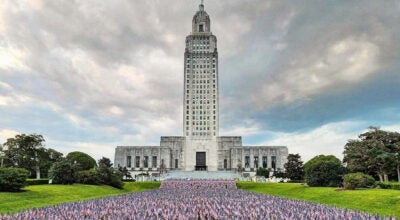St. John looking at paths for trail growth
Published 11:45 pm Tuesday, August 5, 2014
By Monique Roth
L’Observateur
LAPLACE — Chris Clement attended the public meeting on proposed plans for phase four of the Mississippi River Multi-Use Trail for one reason — he’s concerned about Garyville’s bonfire tradition.
Clement, who grew up in Garyville, is concerned about plans for phase four because he said the path’s placement could put even more restrictions on where bonfire enthusiasts locate their fires along the levee in Garyville.
St. John the Baptist Parish Communications Director Paige Falgoust said phase four of the trail includes the levee section from West 10th Street in Reserve to the St. James Parish line. She said phase one and two of the trail run at the crown of the levee, and phase three will run at the toe of the levee in an effort to not disrupt traditional bonfire activity in that area.
At the public meeting, hosted by parish administration and representatives of the Regional Planning Commission and Meyer Engineers LTD, three options were given for the placement of phase four of the trail.
Option one would place the trail on crown of levee, which would not allow for future bonfires in non-industry areas. Lower construction cost, improved user experience and a more scenic route are three positives the Regional Planning Commission highlighted about option one.
Option two would place the trail near or along the toe of the levee in non-industry areas. Officials said this would allow for future bonfires, but would cost $380,000 more than option one. Officials also noted it would be more difficult to get Levee Board permits for option two, and the maintenance costs associated with option two would be higher.
Option three would place the trail on the crown of levee with bonfire shelves, which would allow future bonfires in non-industry areas.
Option three would cost $28,000 more than option one, based on the four bonfire shelves. Permitting difficulties were cited again for this option.
Clement said he is in most favor of option two.
“We need to leave the tradition unaffected and unaltered for my kids and for the next generation,” Clement said, adding he felt as though officials were leaning toward whatever option cost less.
Parish President Natalie Robottom said the project is primarily funded through a DOTD grant, which is competitive in nature.
“They will have a large say in how their dollars are ultimately spent, but we will continue to work toward a viable resolution to all concerns,” Robottom said.
Robottom said she and other officials have always considered the residents’ wishes, which is why phase three is at the toe of the levee.
“The consultants have researched viable options for extending the trail, while allowing the existing bonfires to continue and will continue to look into additional recommendations made at the meeting,” Robottom said.
Parish administration said the public meeting on phase four was extremely productive and resulted in several great comments and suggestions, adding that a feasibility study should be scheduled to conclude by the end of March and a final conceptual plan should be ready by the end of the spring.
Robottom said in the end, permitting from the Corps of Engineers, Levee Board and DOTD, as well as landowner permission, safety and costs, will be the determining factors for the final project.
Construction on the trail, designed for walking, touring or biking along levee, began in 2011.
The first phase of the trail, a 2.5-mile paved path extending from the parish line at Lewis Street to the Walnut Street area near Emily C. Watkins Elementary School, was completed in October 2011.
The second phase, which stretches 2.84 miles from Walnut Street to Our Lady of Grace Church in Reserve, was completed in 2012.
Falgoust said the third phase of the trail extends the path from Our Lady of Grace to West 10th Street in Reserve, and work on that phase will begin in the spring.





